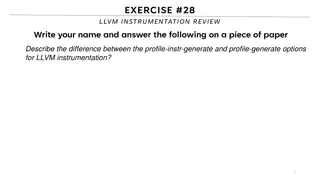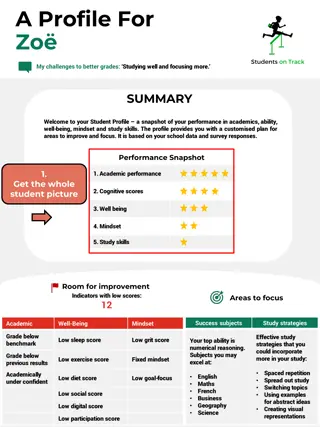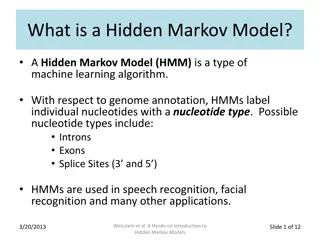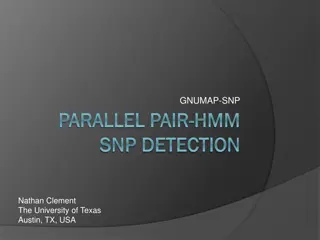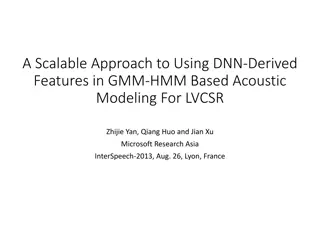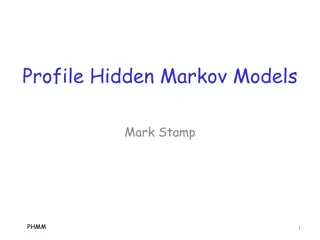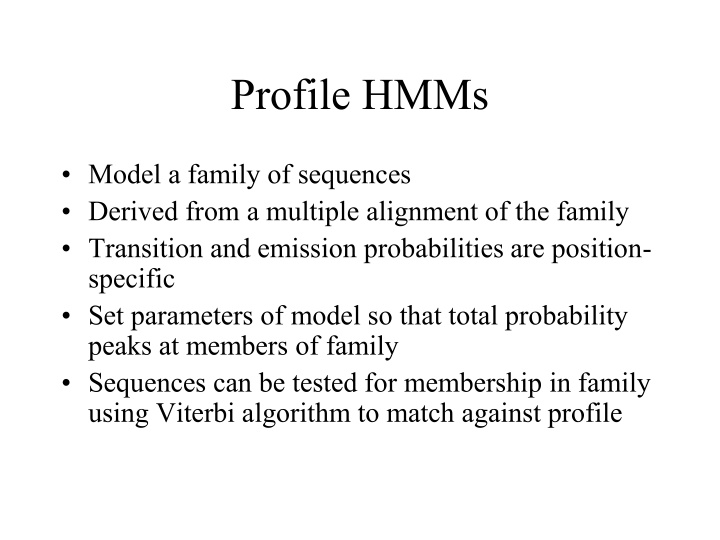
Profile HMMs and Protein Family Characterization
Learn about Profile HMMs for sequences, transition probabilities, and using Viterbi algorithm for family membership testing. Explore methods like regular expressions and consensus sequences for protein family characterization. Dive into the world of Hidden Markov Models (HMMs) and their role in identifying common features in protein families.
Uploaded on | 2 Views
Download Presentation

Please find below an Image/Link to download the presentation.
The content on the website is provided AS IS for your information and personal use only. It may not be sold, licensed, or shared on other websites without obtaining consent from the author. If you encounter any issues during the download, it is possible that the publisher has removed the file from their server.
You are allowed to download the files provided on this website for personal or commercial use, subject to the condition that they are used lawfully. All files are the property of their respective owners.
The content on the website is provided AS IS for your information and personal use only. It may not be sold, licensed, or shared on other websites without obtaining consent from the author.
E N D
Presentation Transcript
Profile HMMs Model a family of sequences Derived from a multiple alignment of the family Transition and emission probabilities are position- specific Set parameters of model so that total probability peaks at members of family Sequences can be tested for membership in family using Viterbi algorithm to match against profile
Profile HMMs: Example Note: These sequences could lead to other paths.
A Characterization Example How could we characterize this (hypothetical) family of nucleotide sequences? Keep the Multiple Alignment Try a regular expression [AT] [CG] [AC] [ACTG]* A [TG] [GC] But what about? T G C T - - A G G vrs A C A C - - A T C Try a consensus sequence: A C A - - - A T C Depends on distance measure Example borrowed from Salzberg, 1998 4
HMMs to the rescue! Emission Probabilities Transition probabilities 5
Scoring our simple HMM #1 - T G C T - - A G G vrs: #2 - A C A C - - A T C Regular Expression ([AT] [CG] [AC] [ACTG]* A [TG] [GC]): #1 = Member #2: Member HMM: #1 = Score of 0.0023% #2 Score of 4.7% (Probability) #1 = Score of -0.97 #2 Score of 6.7 (Log odds) 7
Pfam A comprehensive collection of protein domains and families, with a range of well-established uses including genome annotation. Each family is represented by two multiple sequence alignments and two profile-Hidden Markov Models (profile-HMMs). A. Bateman et al. Nucleic Acids Research (2004) Database Issue 32:D138-D141
Methods for Characterizing a Protein Family Objective: Given a number of related sequences, encapsulate what they have in common in such a way that we can recognize other members of the family. Some standard methods for characterization: Multiple Alignments Regular Expressions Consensus Sequences Hidden Markov Models 9
Aligning and Training HMMs Training from a Multiple Alignment Aligning a sequence to a model Can be used to create an alignment Can be used to score a sequence Can be used to interpret a sequence Training from unaligned sequences 10
Training from an existing alignment This process what we ve been seeing up to this point. Start with a predetermined number of states in your HMM. For each position in the model, assign a column in the multiple alignment that is relatively conserved. Emission probabilities are set according to amino acid counts in columns. Transition probabilities are set according to how many sequences make use of a given delete or insert state. 11
Remember the simple example Chose six positions in model. Highlighted area was selected to be modeled by an insert due to variability. Can also do neat tricks for picking length of model, such as model pruning. 12
Training from unaligned sequences One method: Start with a model whose length matches the average length of the sequences and with random emission and transition probabilities. Align all the sequences to the model. Use the alignment to alter the emission and transition probabilities Repeat. Continue until the model stops changing By-product: It produced a multiple alignment 13
Training from unaligned continued Advantages: You take full advantage of the expressiveness of your HMM. You might not have a multiple alignment on hand. Disadvantages: HMM training methods are local optimizers, you may not get the best alignment or the best model unless you re very careful. Can be alleviated by starting from a logical model instead of a random one. 14








